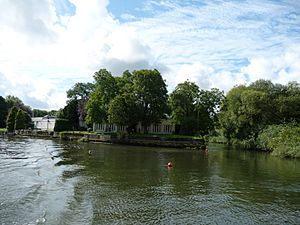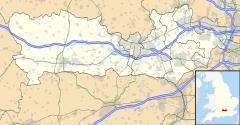Monkey Island, Bray facts for kids
Quick facts for kids Monkey Island |
|
|---|---|
 The head of Monkey Island |
|
| Ceremonial county | |
| Region | |
| Country | England |
| Sovereign state | United Kingdom |
| Police | Thames Valley |
| Fire | Royal Berkshire |
| Ambulance | South Central |
| EU Parliament | South East England |
Monkey Island is a small island in the River Thames in England. It is located near the village of Bray, Berkshire. Since the late 1800s, the main building on the island has been a hotel.
The part of the river where the island sits is very popular for boat trips. Many people enjoy touring between Windsor and Maidenhead. Monkey Island has been a popular place to visit since the 1700s. This became especially true after the Duke of Marlborough bought it in 1738. He was famous for Blenheim Palace. The Duke placed colorful monkey statues in his gardens for visitors to find. Some of these statues are still in one of his two small buildings on the island. These buildings were designed by architect Robert Morris.
Contents
What's in a Name?
The name "Monkey" comes from an old English word. It means "Monks' Island" or Monks Ey(ot). Monks probably visited the island often. They might have fished there to get food. These monks lived and worked at Amerden Bank, a moated site near Bray Lock. This was part of Merton Priory from 1197. Later, another religious house used it until the Dissolution of the Monasteries.
By the 1300s, the island belonged to the Canonesses of Burnham Abbey. This abbey was about a mile north of the island. In old records from 1361, the island was called Bournhames Eyte. Many islands in the Thames had religious connections. The name Burnham-Ayt also appeared on a map in 1640.
In 1606, the Englefield family owned the island. After the Great Fire of London in 1666, stone and bricks were brought from Oxfordshire to rebuild the city. On their way back, the barges carried rubble. This rubble was spread on some Thames islands. This helped stop erosion and made the land bigger.
The Duke's Special Island
In 1738, the Duke of Marlborough bought Monkey Island. He bought it from Sir Francis Englefield. The Duke had seen the island while visiting a club nearby. He loved to fish. He built the first two buildings on the island for his fishing hobby. These buildings were called the fishing lodge and the fishing temple. Today, they are known as the Pavilion and the Temple.
The famous architect Robert Morris designed both buildings. They cost a lot of money to build. Another person, the ninth Earl of Pembroke, also helped design the Temple.
The Fishing Lodge (Pavilion)
The Pavilion looks like it's made of stone blocks. But it's actually built from colored wood blocks. This was a special type of carpentry during the Georgian period. Inside, the Duke had unique paintings called Singerie. These paintings showed monkeys doing human things. For example, they were playing cards, shooting, fishing, and smoking. The French artist Andieu de Clermont painted them before 1738.
The Duke's unusual decorations made some people call the island "Marlborough’s Folly." Lady Hertford described the Pavilion after it was finished. She was both impressed and surprised:
The main room is painted on the ceiling with funny pictures of monkeys fishing and shooting. Its walls are covered with paper. When you sit in this room, you can't see the water. This is even though the island is very small. It's not because of trees, as there are only a few. It's because the river runs much lower than the island's banks.
The Fishing Temple (Temple)
The Temple is about 100 yards from the Pavilion. It used to be open on the ground floor, like a market stall. The Duke's interesting style can also be seen in the room on the first floor. This room was once a billiard room. Its beautiful ceiling has figures of Neptune, shells, and mermaids. These are made of plasterwork in the style of Wedgwood. Some say Roberts of Oxford did this work around 1725. Others say it was William Perritt.
The Duke of Marlborough passed away in 1758. In 1787, Henry Townley Ward bought the island. He later left it to P.C. Bruce.
From Inn to Grand Hotel
By 1840, the Pavilion had become a riverside inn. People reached it by ferry. By the mid-1800s, the hotel was called the "Monkey Hall Hotel." Visitors have been staying in the buildings ever since. It became very popular after 1900. King Edward VII and Queen Alexandra often had tea on the lawns with their children.
The famous composer Edward Elgar wrote his violin concerto in 1910. He wrote it in a house on the riverbank facing Monkey Island. Music stars like Clara Butt and Nellie Melba also entertained guests there. From 1912, the writers Rebecca West and H. G. Wells often visited the island. Rebecca West even set her first novel, Return of the Soldier, there. The main character was the innkeeper's daughter.
Modern Changes and Popularity
In the middle of the 1900s, many new parts were added to the island. The buildings were also updated. In 1956, a footbridge was built. This bridge connects the island to the shore. This happened after Christopher Reynolds bought the island.
In 1963, the Pavilion's dining area got bigger. The River Room was added. This is a large, glass-walled building that hangs over the Thames. In 1970, the Marlborough Room was added. Its walls were painted with battle scenes. In the same year, the Temple was made larger. It gained 30 more bedrooms. Both the Pavilion and Temple are now Grade I listed buildings. This means they are very important historical buildings.
Mr. Reynolds owned the island from 1956 to 1971. He made the island popular again with his thoughtful additions. Monkey Island continued to be a favorite spot. In 1964, it hosted a charity ball for Oxfam. A magazine called Tatler covered it with the headline "Oxfam-On-Thames."
In 1967, Mr. Reynolds started Monkey Island's own magazine, The Islander. The first issue talked about the island's popular Club Suppers and Ladies' Luncheon Club. It also mentioned entertainment by Jimmy Fraser and Mike Allen.
The hotel was later bought by Major Fitzwilliams. Then it was sold to the Weinreb Group. In 1976, Paul and Liz Nichols bought the hotel. They did many renovations during their nine years there. The hotel received awards and good reviews from famous guides.
In 1986, Basil Faidi bought the hotel. He continued to restore the historic buildings. About 10 years later, the Habtour Group bought it. Then, Dr. Andreas C. Papadakis bought it in September 2007.
In 2015, YTL Hotels bought Monkey Island. They renamed it Monkey Island Estate. After a big renovation, the new luxury hotel opened in April 2019. Champalimaud Design, from New York, designed the 41 bedrooms and suites. Monkey Island Estate has a special Floating Spa. It is moored on the banks of the River Thames. The property also has the Monkey Island Brasserie. This restaurant serves breakfast, lunch, and dinner. It offers modern British food. The ingredients are fresh from the nearby countryside.



